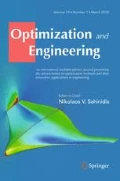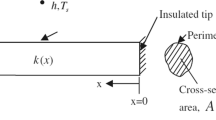Abstract
A fin serves as an extended surface to enhance the heat transfer from a larger heated mass to which it is attached. We use a multiobjective optimization (MO) approach for a fin in steady-state to analyze the dynamics of effectiveness and efficiency simultaneously. Our approach is based on a piecewise linear approximation of the design. We use the \(\epsilon\)-constraint method of MO to identify Pareto points for effectiveness and efficiency and hence the Pareto design of the fin. We conduct several numerical experiments using the fmincon routine from the MATLAB. The numerical experiments show that our approach provides a unique interaction between effectiveness and efficiency independent from the initial profiles within the user-defined tolerance range of the fmincon routine.






Similar content being viewed by others
Abbreviations
- x :
-
Coordinate along the fin, \(0\le x\le L,\) m
- L :
-
Length of the fin, m
- r(x):
-
Radius of cross section, m
- \(\rho (x)\) :
-
Dimensionless radius of cross section
- \(^d\) :
-
Index that denotes discrete approximation
- A(x):
-
Area of cross section of the fin, \({\mathrm{m}}^2\)
- \(A_s(x)\) :
-
Surface area of the fin on the interval [0, x], \({\mathrm{m}}^2\)
- \(A_s^0(x)\) :
-
Dimensionless area
- \(dA_s(x)\) :
-
Differential surface area, \({\mathrm{m}}^2\)
- \(A_b=A(0)\) :
-
Base area, \({\mathrm{m}}^2\)
- \(q_f\) :
-
Heat transfer rate, W
- \(Bi=hL/k\) :
-
Biot number, dimensionless
- n :
-
Number of intervals in discretization algorithm
- \(\varDelta =L/n,\) :
-
m
- h :
-
The convective heat transfer coefficient, \({\mathrm{W}}/({\mathrm{m}}^2\,{\mathrm{K}})\)
- k :
-
The conduction coefficient, \({\mathrm{W}}/({\mathrm{m}}\,{\mathrm{K}})\)
- T(x):
-
Temperature of fin, \(^\circ {\mathrm{C}}\)
- \(T_b\) :
-
Fin base temperature, \(^\circ {\mathrm{C}}\)
- \(T_{\infty }\) :
-
Surrounding fluid temperature, \(^\circ {\mathrm{C}}\)
- V :
-
Volume of the fin, \({\mathrm{m}}^3\)
- \(m_j=\frac{r_{j+1}-r_j}{\varDelta }\) :
-
Slope, dimensionless
- \(\epsilon _f\) :
-
Fin effectiveness, dimensionless
- \(\tau (x)\) :
-
Normalized temperature, dimensionless
- \(I_s(u)\) :
-
And \(K_s(u),\,s=1,2\) the modified Bessel functions of order s of the first and second kind
- \(\kappa\) :
-
Parameter characterizing the initial \(\kappa\) profile, dimensionless
- \({\mathcal {R}}^p\) :
-
\(p-\)dimensional Euclidean vector space
- \(f=(f_1,\dots ,f_p)^T\) :
-
Vector valued-function
- X :
-
Set of all feasible solutions of the MOP
- \(Y:=f(X)\) :
-
Set of all outcome vectors of the MOP
References
Abramowitz M, Stegun IA (1964) Handbook of mathematical functions with formulas, graphs, and mathematical tables, National Bureau of Standards. Appl Math Ser - 55, Washington, D.C
Barman D, Goswami D, Kundu B (2013) An optimum longitudinal wet fin without the “length-of-arc” assumption. HVAC R Res 19:444–456
Belinskiy BP, McCarthy CM, Walters TJ (2003) The optimal design of a turbine. Eur Ser Appl Ind Math Control Optim Calc Var (ESAIM: COCV) 9:217–230
Belinskiy BP, Hiestand JW, Matthews JV (2015) Piecewise uniform optimal design of a bar with an attached mass. Electron J Differ Equ 206:1–15
Belinskiy BP, Hiestand JW, Weerasena L (2020) Optimal design of a fin in steady-state. Appl Math Model 77(Part 2):1188–1200. https://doi.org/10.1016/j.apm.2019.09.038
Bergman TL, Lavine AS, Incropera FP, Dewitt DP (2011) Fundamentals of heat and mass transfer, 7th edn. Wiley, New York
Cardou A (1973) Piecewise uniform optimum design for axial vibration requirement. AIAA J 11:1760–1761. https://doi.org/10.2514/3.50684
Chankong V, Haimes YY (1983) Multiobjective decision making: theory and methodology. In: North Holland series in system science and engineering, 8, North-Holland
Cox SJ, McCarty M (1998) The shape of the tallest column. SIAM J Math Anal 29:547–554. https://doi.org/10.1137/S0036141097314537
Das R (2011) A simplex search method for a conductive-convective fin with variable conductivity. Int J Heat Mass Transf 54:5001–5009. https://doi.org/10.1016/j.ijheatmasstransfer.2011.07.014
Das R (2014) Feasibility study of different materials for attaining similar temperature distributions in a fin with variable properties. Proc IMch Part E J Process Mech Eng 230:292–303. https://doi.org/10.1177/0954408914548742
Das R (2015) Estimation of feasible materials and thermal conditions in a trapezoidal fin using genetic algorithm. Proc IMch Part G J Aerosp Eng 230:2356–2368. https://doi.org/10.1177/0954410015623975
Das R, Kundu B (2018) Direct and inverse approaches for analysis and optimization of fins under sensible and latent heat load. Int J Heat Mass Transf 124:331–343. https://doi.org/10.1016/j.ijheatmasstransfer.2018.03.059
Das R, Kundu B (2019) Forward and inverse nonlinear heat transfer analysis for optimization of a constructal T-shape fin under dry and wet conditions. Int J Heat Mass Transf 137:461–475. https://doi.org/10.1016/j.ijheatmasstransfer.2019.03.097
Das R, Singh K, Akay B, Gogoi TK (2016) Application of artificial bee colony algorithm for maximizing heat transfer in a perforated fin. Proc IMchE Part E J Process Mech Eng 232:38–48. https://doi.org/10.1177/0954408916682985
Deb K, Pratap A, Agarwal S, Meyarivan T (2002) A fast and elitist multiobjective genetic algorithm: NSGA-II. IEEE Trans Evol Comput 6:182–197
Deka A, Datta D (2017) A comparative investigation of annular fins of different profiles using multi-objective genetic algorithm. In: Proceedings of 2017 international conference on advances in mechanical, industrial, automation and management systems (AMIAMS) 74–79
Ehrgott M (2005) Multicretirea optimization, 2nd edn. Springer, Berlin
Fletcher R (1987) Practical methods of optimization. Wiley, Amsterdam
Ghanadi Arab MM, Hajabdollahi M, Hajabdollah H (2013) Multi-objective optimization of a fin with two-dimensional heat transfer using NSGA-II and ANN. J Appl Mech Eng 2:1–7
Haimes YV, Lasdon LS, Wismer DA (1971) On a bicriterion formation of the problems of integrated system identification and system optimization. IEEE Trans Syst Man Cybern 3:296–297
Hajabdollahi F, Rafsanjani HH, Hajabdollahi Z (2012) Multi-objective optimization of pin fin to determine the optimal fin geometry using genetic algorithm. Appl Math Model 36:244–254
Hanin LG (2008) A new optimum pin fin beyond the “length-of-arc” assumption. Heat Transf Eng 29:608–614. https://doi.org/10.1080/01457630801922360
Hanin LG, Campo A (2003) A new minimum volume straight cooling fin taking into account the “length of arc”. Int J Heat Mass Transf 46:5145–5152
Jany P, Bejan A (1988) Ernst Schmidt’s approach to fin optimization: an extension to fins with variable conductivity and the design of ducts for fluid flow. Int J Heat Mass Transf 31:1635–1644. https://doi.org/10.1016/0017-9310(88)90276-1
Kraus AD, Aziz A, Welty J (2007) Extended surface heat transfer, 1st edn. Wiley, NY
Kundu B (2010) A new methodology for determination of an optimum fin shape under dehumidifying conditions. Int J Refrig 33:1105–1117. https://doi.org/10.1016/j.ijrefrig.2010.04.001
Kundu B, Lee K-S (2015) Exact analysis for minimum shape of porous fins under convection and radiation heat exchange with surrounding. Int J Heat Mass Transf 81:439–448. https://doi.org/10.1016/j.ijheatmasstransfer.2014.10.044
Lienhard JH IV, Lienhard JH V (2018) A heat transfer textbook, 4th edn. Phlogiston Press, Cambridge
Liu C, Bu W, Xu D (2017) Multi-objective shape optimization of a plate-fin heat exchanger using CFD and multi-objective genetic algorithm. Int J Heat Mass Transf 111:65–82
Maday CJ (1974) The minimum weight one-dimensional straight cooling fin. J Eng Ind 96:161–165. https://doi.org/10.1115/1.3438291
MathWorks. https://www.mathworks.com/help/optim/ug/fmincon.html/, 2019. Accessed 10 November 2019
Natarajan U, Shenoy UV (1990) Optimum shapes of convective pin fins with variable heat transfer coefficient. J Frankl Inst 327:965–982. https://doi.org/10.1016/0016-0032(90)90072-Q
NIST Digital Library of Mathematical Functions. https://dlmf.nist.gov, 2019. Accessed 10 September 2019
Schittkowski K (1985) NLQPL: a FORTRAN-subroutine solving constrained nonlinear programming problems. Ann Oper Res 5:485–500
Schmidt E (1926) Die Wärmeübertragung durch Rippen. Z Ver Dtsch Ing 70:947–951
Singla RK, Das R (2018) A differential evolution algorithm for maximizing heat dissipation in stepped fin. Neural Comput Appl 30:3081–3093
Taylor JE (1967) The strongest column: the energy approach. J Appl Mech 34:486–487. https://doi.org/10.1115/1.3607710
Turner MJ (1967) Design of minimum mass structures with specified natural frequencies. AIAA 5:406–412. https://doi.org/10.2514/3.3994
Wang J, Wang X (2016) The heat transfer optimization of conical fin by shape modification. Chin J Chem Eng Fluid Dyn Transf Phenom 24:972–978. https://doi.org/10.1016/j.cjche.2016.05.010
Wankhade PA, Kundu B, Das R (2018) Establishment of non-Fourier heat conduction model for an accurate transient thermal response in wet fin. Int J Heat Mass Transf 126:911–923. https://doi.org/10.1016/j.ijheatmasstransfer.2018.05.094
Yu Lien-Tsai (1998) Application of Taylor transformation to optimize rectangular fins with variable thermal parameters. Appl Math Model 22:11–21
Acknowledgements
The authors would like to thank the anonymous reviewers for their invaluable comments, which allowed the authors to eliminate some mistakes. Most importantly, the reviewers kindly indicated some directions in the heat transfer research that were new to the authors.
The research of the first author was supported by a Faculty Development Grant at the University of Tennessee at Chattanooga.
Author information
Authors and Affiliations
Corresponding author
Additional information
Publisher's Note
Springer Nature remains neutral with regard to jurisdictional claims in published maps and institutional affiliations.
Rights and permissions
About this article
Cite this article
Weerasena, L., Belinskiy, B.P. & Hiestand, J.W. Optimal effectiveness and efficiency of a fin in steady-state: multiobjective approach. Optim Eng 22, 1157–1180 (2021). https://doi.org/10.1007/s11081-020-09497-9
Received:
Revised:
Accepted:
Published:
Issue Date:
DOI: https://doi.org/10.1007/s11081-020-09497-9




